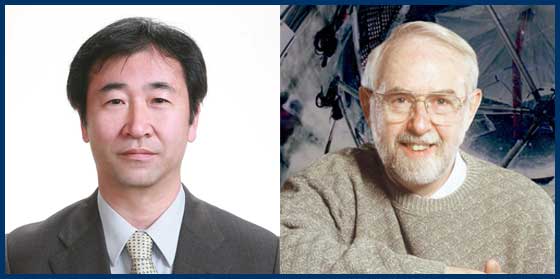By Emily Conover

Photos: (left) University of Tokyo, (right) Queen's University
Takaaki Kajita and Arthur McDonald
The 2015 Nobel Prize in Physics was awarded on October 6 for the discovery of neutrino oscillations, which revealed the unusual behavior of these misfit particles, and indicated that they have mass. The prize honored two scientists who were instrumental in making the discovery: Takaaki Kajita of the University of Tokyo, for his work on the Super-Kamiokande experiment, and Arthur McDonald of Queen’s University at Kingston, Canada for his work on the Sudbury Neutrino Observatory (SNO) experiment.
“Hooray for neutrinos — this is the little particle that punches above weight,” says Michael Turner of the University of Chicago. “It’s truly remarkable how much they’ve taught us about the universe and elementary particles.”
Neutrinos are produced in a variety of nuclear reactions and were once thought to be massless. The particles come in three “flavors” — electron, muon, and tau. But we now know that these flavors are not fixed. In a series of large-scale particle physics experiments performed deep underground, scientists showed that neutrinos oscillate from one flavor to another.
“That really turned neutrino physics on its head,” says Stephen Parke of Fermilab, because in order for neutrinos to oscillate, they must have mass. A massless particle travels at the speed of light, and therefore can’t change, since according to special relativity, its clock doesn’t tick.
In 1998, the Super-Kamiokande experiment saw a telltale signature of oscillation in muon neutrinos that are produced when cosmic rays interact with Earth’s atmosphere. Physicists measured the number of muon neutrinos coming from directly overhead, which passed through the Earth’s atmosphere and flew one kilometer underground to reach the detector. They also measured the number that came from below; to reach the detector, those neutrinos traversed a vastly greater distance through Earth. The experiment revealed a deficit of muon neutrinos from below, indicating conclusively that neutrinos changed flavor during their long journey.
When Kajita first presented Super-Kamiokande’s results during a talk in 1998, “The entire audience realized that the game had just changed,” says Boris Kayser of Fermilab. “Until that point the possibility that neutrinos had nonzero masses was speculation. After that point it was fact.” He adds, “I have never heard more enthusiastic, more prolonged applause for a physics talk than for that one.”
In 2001, SNO clinched the case for oscillation in electron neutrinos produced by the sun. SNO used several detection methods, including one that measured the total number of neutrinos, and one that measured only electron neutrinos. The scientists saw fewer electron neutrinos than expected, but the total number of neutrinos matched theorists’ predictions, indicating that a flavor change was responsible for the electron neutrino shortage.
Previous experiments had shown hints of oscillations, but none that were convincing. “We just didn’t have the smoking-gun evidence,” says Paul Langacker of the Institute for Advanced Study. But SNO and Super-Kamiokande “cleaned everything up and made it compelling so that every physicist understood that, yes, that’s what’s going on.”
The precursor experiments included Ray Davis’ Homestake experiment, which began in the 1960s. Davis’ measurements of solar electron neutrinos resulted in the vexing “solar neutrino problem,” which took decades to sort out. Davis consistently measured only about a third of the number of neutrinos predicted by theorists, most notably John Bahcall. The SNO result definitively clarified this confusing picture — the predicted numbers of neutrinos were indeed born in the sun, but they oscillated into other flavors, making them unobservable in the detector.
“It was a heroic experimental task to sort everything out,” says Langacker.
The prize honors the leaders of Super-Kamiokande and SNO, who worked with their many colleagues to secure the results. On the phone during a press conference announcing the prize, McDonald repeatedly emphasized the contributions of his collaborators, saying, “There’s great camaraderie associated with this work.”
“These are enormous experiments, and they have now given a Nobel Prize to individuals in these experiments. And that is something that hasn’t happened that often before, “says Parke. “I see these two prizes as not only recognizing these two individuals ... but I also see it as a recognition of the two teams.”
McDonald, an APS Fellow, previously won the APS Tom W. Bonner Prize in Nuclear Physics in 2003. Kajita received the APS W.K.H. Panofsky Prize in Experimental Particle Physics in 2002.
The discovery that neutrinos oscillate, and hence the implication that they have mass, has led physicists to some intriguing puzzles. In the Standard Model of particle physics, neutrinos are massless. “That tells us that this amazing model we have of how the world works is incomplete and there’s more to be discovered,” says Turner. APS President Sam Aronson said, in a statment, “The discovery has major bearing on the structure of the universe as well as the physics of the nucleus.”
Precise values of the neutrino masses are still unknown, but physicists do know that neutrino masses are oddly tiny — a million times smaller than the electron mass. Some physicists believe there may be different physics underlying the masses of the neutrinos than of other particles. Massive neutrinos could also be a key to understanding the source of the matter-antimatter imbalance in our universe. And there may be other types of lurking, undetected neutrinos, known as “sterile” neutrinos.
“This is not the end; this is really the beginning,” says Turner.
Related Information
A number of key papers from the two experiments were published in the APS journal Physical Review Letters and are free to read:





©1995 - 2024, AMERICAN PHYSICAL SOCIETY
APS encourages the redistribution of the materials included in this newspaper provided that attribution to the source is noted and the materials are not truncated or changed.
Editor: David Voss
Staff Science Writer: Emily Conover
Contributing Correspondent: Alaina G. Levine
Art Director and Special Publications Manager: Kerry G. Johnson
Publication Designer and Production: Nancy Bennett-Karasik
November 2015 (Volume 24, Number 10)
Articles in this Issue

